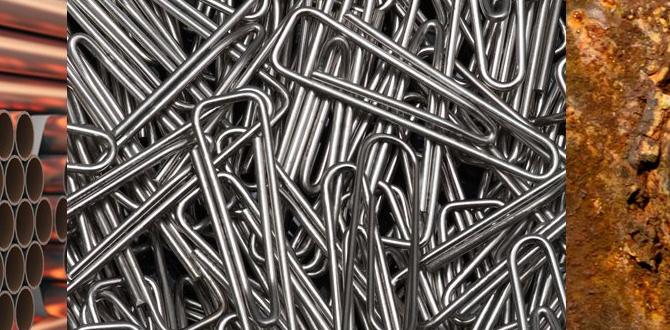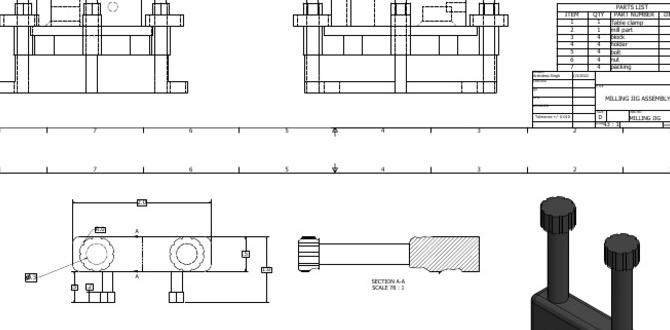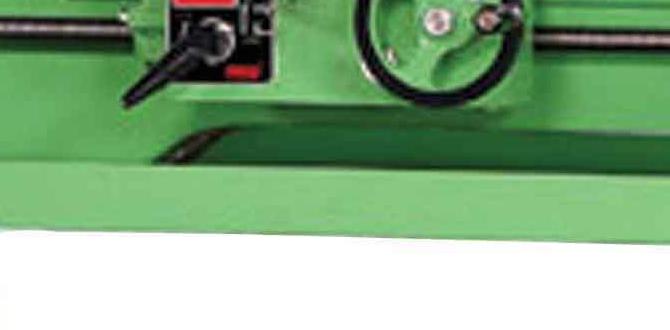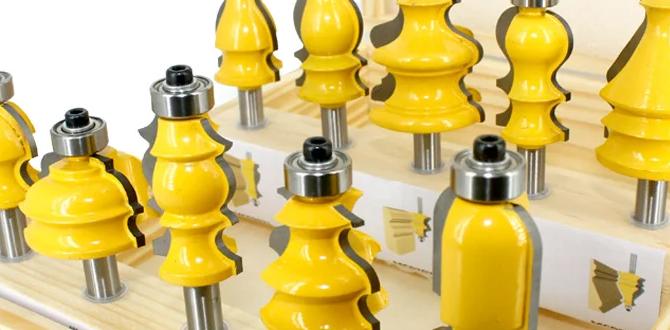Have you ever wondered how wood or metal is shaped into smooth, round objects? One of the most fascinating methods is lathe turning. This process can create amazing designs, but did you know that lathe turning can make both parallel and tapered shapes? These two techniques can lead to very different results.
Imagine you want to make a new toy top. Should it be flat and straight, or should it taper like a cone? Understanding the difference between parallel and tapered shapes helps you decide. Parallel shapes stay the same width from start to finish. Tapered shapes, however, get thinner or wider towards the end. This simple difference can change how your object looks and functions.
In this article, we will explore the exciting world of lathe turning. We will dive into the benefits and uses of both parallel and tapered shapes. By the end, you’ll know which style to choose for your next project. Get ready to discover how lathe turning can bring your ideas to life!
Lathe Turning: Parallel Vs Tapered Shapes Explained Lathe Turning Is A Fundamental Machining Process Used To Create Various Shapes And Sizes Of Objects, Particularly In Metalworking. Understanding The Difference Between Parallel And Tapered Shapes Is Crucial For Machinists And Those Involved In Precision Engineering. Here, We Will Delve Into The Characteristics, Applications, And Benefits Of Both Parallel And Tapered Turning Shapes. What Is Lathe Turning? Lathe Turning Is The Technique Of Rotating A Workpiece Around A Fixed Axis To Produce Symmetrical Parts. It Often Involves Cutting Tools That Shape The Material By Removing Excess Material From The Workpiece’S Surface. This Process Can Be Employed On Different Materials, Including Metals, Plastics, And Wood. Parallel Shapes Definition Parallel Shapes Refer To Cylindrical Objects Where The Diameter Remains Constant Over The Entire Length. The Surface Of These Shapes Is Uniform And Does Not Taper Or Change Shape. Applications Parallel Turning Is Commonly Used For Shafts, Rods, And Bushings. These Components Are Essential In Machinery As They Allow Smooth Movement And Precision Operation. Common Uses Include: – **Spindles:** Rotating Components In Machines. – **Pulleys:** Rotary Equipment That Helps In Motion Transmission. – **Bushings Or Sleeves:** Used As Bearings To Reduce Friction. Benefits 1. **Simplicity In Design:** Easier To Manufacture And Often Less Costly. 2. **Reduced Tool Wear:** Consistent Surface Means Uniform Cutting, Decreasing Wear On Tooling. 3. **Higher Accuracy:** Ideal For Applications Requiring Tight Tolerances. Tapered Shapes Definition Tapered Shapes Feature A Gradual Reduction In Diameter Along The Length Of The Workpiece, Creating A Conical Or Frustum Design. Applications Tapered Turning Is Essential In Producing Various Components That Require Fitment Into Another Part, Such As: – **Tapered Pins:** Used In Assembly Systems. – **Cone Cutters:** For Specific Cutting Applications. – **Automotive Parts:** Like Axle Shafts That Require Specific Fitting. Benefits 1. **Enhanced Fitment:** Facilitates Better Assembly Of Parts With Different Diameters. 2. **Improved Aerodynamics:** Critical In Applications Where Airflow Or Fluid Dynamics Is Essential. 3. **Aesthetic Appeal:** Often Desired In Design For Its Sleek And Modern Look. Key Differences: Parallel Vs Tapered – **Shape Consistency:** Parallel Shapes Maintain A Constant Diameter, While Tapered Shapes Decrease Progressively. – **Applications:** Parallel Is More Suited For Machinery, While Tapered Is Favored For Components Needing Precise Fit. – **Manufacturing Complexity:** Tapered Shapes May Require More Intricate Tooling And Setup Than Parallel Shapes. Conclusion Both Lathe Turning Parallel And Tapered Shapes Have Unique Applications And Benefits. Choosing The Right One Depends On The Specific Needs Of The Project, Including Mechanical Functionality And Design Requirements. Understanding These Differences In Lathe Turning Shapes Enhances The Machinist’S Ability To Produce Precise, Functional Components Tailored To Their Intended Use.
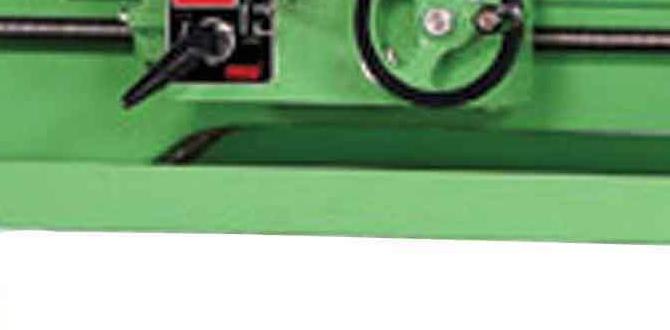
Lathe Turning: Parallel vs. Tapered Shapes
Lathe turning shapes can either be parallel or tapered. Do you know the difference? Parallel shapes maintain the same width throughout. This makes them great for parts needing uniformity. Tapered shapes, however, gradually change in width. This design is perfect for creating objects like cones. A fun fact: tapered shapes can add style to everyday items! Understanding these differences helps in choosing the right design for your projects. Are you ready to turn your ideas into reality?Types of Shapes Produced by Lathe Turning
Explanation of parallel shapes. Explanation of tapered shapes.Lathe turning makes two main shapes: parallel and tapered. Parallel shapes are straight and uniform. They look like a soda can. This means every part has the same width. Tapered shapes, on the other hand, are like a road that gets narrower. They start wider and finish smaller, similar to an ice cream cone. Both shapes have their uses in crafting and engineering.
| Shape Type | Description | Example |
|---|---|---|
| Parallel | Even thickness throughout. | Soda can |
| Tapered | Gradually decreases in width. | Ice cream cone |
In turning, the choice of shape affects strength and look. Remember, tapering can make parts lighter but still strong. It’s like wearing a hat that’s stylish and actually keeps you warm!
Characteristics of Parallel Shapes
Details on dimensions and measurements. Applications and industries that use parallel shapes.Parallel shapes have a few special characteristics that make them essential in many industries. They have the same width all along, which makes measuring them a breeze. For example, if a cylinder is parallel, its diameter stays the same from one end to the other. This consistency is important in fields like manufacturing and engineering where precision is key.
Applications for these shapes include everything from pistons in engines to shafts in machines. Industries such as automotive, aerospace, and furniture rely on parallel shapes for strong and dependable components. A lack of variation means less risk of error—and who doesn’t love fewer mistakes? So, the next time you see a straight piece of wood or metal, remember, it could have a pretty important job!
| Industry | Application |
|---|---|
| Manufacturing | Precision tools |
| Aerospace | Aircraft components |
| Automotive | Engine parts |
| Furniture | Table legs |
Characteristics of Tapered Shapes
Details on angles and dimensions. Applications and advantages of tapered shapes.Tapered shapes have special angles that create a pointy end. They narrow down from a wider part to a thinner part. This design helps in many areas like making chairs comfy or fitting things together snugly. The angle is super important! A gentle slope can make things look nice; a steeper angle can create a fun effect. Tapered shapes are strong and can hold weight well.
| Application | Advantage |
|---|---|
| Furniture | Easy to fit in small spaces |
| Tooltips | Helps in cutting and shaping |
| Builds | Looks fancy and stylish |
In short, tapered shapes aren’t just pretty; they are practical too! Who knew being pointy could be so useful?
Comparison of Parallel and Tapered Shapes
Key differences in design and functionality. Pros and cons of each shape type.Parallel shapes are straight and even from end to end. They are easy to make and fit together well. Tapered shapes, however, narrow towards one end. This design makes them perfect for projects needing a point. Each shape has its strengths and weaknesses:
- Parallel Shapes: Simple to measure and cut, but can take up more space.
- Tapered Shapes: Great for reducing weight, but can be tricky to create accurately.
Understanding these differences helps in choosing the right shape for a project. What design works best for you? Think about your needs first!
What are the main differences between parallel and tapered shapes?
Parallel shapes are straight and easy to create, while tapered shapes have a gradual point, making them more specialized and useful in certain situations.
Techniques for Lathe Turning
Tools and equipment used for both shapes. Best practices for achieving precision.Using the right tools is essential for lathe turning. For parallel shapes, you need a straight cutting tool and a tailstock to keep things steady. Tapered shapes require a taper attachment for accurate angles.
Best practices play a huge role in achieving precision. Always measure twice before cutting to prevent mistakes. Here are a few tips:
- Keep your tools sharp.
- Use the right speed for your material.
- Check your setup before starting.
With practice, anyone can master these techniques! Always remember, safety first while working with machines.
What tools are needed for lathe turning?
You need specific tools for lathe turning. A straight cutting tool is crucial for parallel shapes. For tapered shapes, use a taper attachment. Safety gear is also important!
Common Mistakes in Lathe Turning
Frequent errors when creating parallel shapes. Frequent errors when creating tapered shapes.In lathe turning, it’s easy to mix up parallel and tapered shapes. Common mistakes come from not measuring correctly. For parallel shapes, some forget to keep the diameter consistent. This leads to a lopsided creation that looks more like a banana than a cylinder. For tapered shapes, the error usually shows when the angle isn’t right. You might end up with a weirdly shaped cone, better suited for a circus than your workshop! Check out our handy table for a quick guide:
| Error Type | Description |
|---|---|
| Parallel Shapes | Inconsistent diameter leads to uneven results. |
| Tapered Shapes | Wrong angle can create unintentional shapes. |
Remember, measuring twice isn’t just a saying; it saves you from making a shape that’ll make you groan!
Best Practices for Lathe Turning
Tips for achieving great results. Maintenance and care of lathe machines.For the best lathe turning results, follow these tips. First, keep tools sharp. A sharp tool gives smoother cuts. Second, do not rush. Take time to measure and adjust. Lastly, clean your lathe regularly. Dust can cause issues. Well-maintained machines last longer and work better.
- Check belts and bearings often.
- Lubricate moving parts regularly.
- Store tools safely to avoid damage.
What is the best way to maintain a lathe?
The best maintenance includes regular cleaning, lubrication, and checking for wear. Clean parts help it run smoothly, while oil keeps them moving without trouble.
Future Trends in Lathe Turning
Innovations in lathe technology. Potential shifts in design preferences for shapes.In the world of lathe turning, exciting innovations are on the rise. New technologies are making machines faster and more accurate. This helps in creating perfect shapes with less effort. Additionally, designs are changing as people learn more about new materials. There’s an increasing interest in both parallel and tapered shapes. Here are some trends:
- Advanced sensors for better precision.
- More eco-friendly materials are being used.
- Customization is becoming popular.
These developments could shape the future of lathe turning significantly.
What are the main innovations in lathe technology?
Some main innovations include smart machines that can adjust settings automatically, and 3D printing capabilities that work alongside traditional lathe methods. These changes improve efficiency and allow for more complex designs with ease.
Conclusion
In conclusion, lathe turning creates both parallel and tapered shapes. Parallel shapes stay the same size along their length, while tapered shapes gradually change size. Understanding these differences helps you choose the right technique for your projects. Try practicing with both types to improve your skills. For more details, explore guides on lathe turning that can enhance your knowledge!FAQs
Sure! Here Are Five Related Questions On The Topic Of Lathe Turning Parallel Vs Tapered Shapes:Sure! When you use a lathe, you can make shapes that are straight, called parallel, or shapes that get smaller or larger, called tapered. Making parallel shapes means both ends are the same size. Tapered shapes look like cones, getting thinner or thicker. This is useful for different projects, like making a table leg or a cone shape. Both methods are fun and help us create cool things!
Sure! Please provide me with the question you’d like me to answer.
What Are The Primary Differences In The Cutting Techniques Used For Turning Parallel Shapes Compared To Tapered Shapes On A Lathe?When you make a parallel shape, you keep the tool straight and move it evenly along the piece. This makes the sides straight and smooth. For tapered shapes, you tilt the tool at an angle. This helps create a point that is thinner at one end and wider at the other. So, the main difference is in how you position the tool while cutting.
In Which Applications Would A Tapered Shape Be Preferred Over A Parallel Shape When Using A Lathe?We would use a tapered shape instead of a parallel shape for certain tools and parts. For example, when making a cone or a point, like a pencil tip, a tapered shape is better. It helps parts fit together nicely, like a funnel for pouring. Tapers are also good for reducing weight while keeping strength.
How Do The Tool Paths Differ When Creating Parallel Versus Tapered Shapes On A Lathe?When you make a parallel shape on a lathe, the tool moves straight along the piece. This keeps the sides even and flat. For tapered shapes, the tool moves at an angle. This creates a pointy end, making one side wider and the other side narrower. So, the paths are straight for parallel shapes and angled for tapered shapes!
What Are The Key Considerations For Setting Up A Lathe To Achieve Accurate Tapered Turning Versus Parallel Turning?When setting up a lathe for tapered turning, you need to adjust the tailstock. This helps create the angled shape of the taper. For parallel turning, keep the tailstock straight and level. You also want to choose the right cutting speed and tool. This way, your workpiece will be smooth and accurate.
How Does The Choice Between Parallel And Tapered Shapes Affect The Mechanical Properties And Performance Of The Finished Component?When we choose between parallel and tapered shapes, it can change how strong our finished piece is. Parallel shapes are usually stronger because they have a consistent width. Tapered shapes can be lighter and use less material but may not be as strong in some areas. This means the shape we pick will affect how well our piece works and lasts. So, we need to think carefully about what we need it to do!
{“@context”:”https://schema.org”,”@type”: “FAQPage”,”mainEntity”:[{“@type”: “Question”,”name”: “Sure! Here Are Five Related Questions On The Topic Of Lathe Turning Parallel Vs Tapered Shapes:”,”acceptedAnswer”: {“@type”: “Answer”,”text”: “Sure! When you use a lathe, you can make shapes that are straight, called parallel, or shapes that get smaller or larger, called tapered. Making parallel shapes means both ends are the same size. Tapered shapes look like cones, getting thinner or thicker. This is useful for different projects, like making a table leg or a cone shape. Both methods are fun and help us create cool things!”}},{“@type”: “Question”,”name”: “”,”acceptedAnswer”: {“@type”: “Answer”,”text”: “Sure! Please provide me with the question you’d like me to answer.”}},{“@type”: “Question”,”name”: “What Are The Primary Differences In The Cutting Techniques Used For Turning Parallel Shapes Compared To Tapered Shapes On A Lathe?”,”acceptedAnswer”: {“@type”: “Answer”,”text”: “When you make a parallel shape, you keep the tool straight and move it evenly along the piece. This makes the sides straight and smooth. For tapered shapes, you tilt the tool at an angle. This helps create a point that is thinner at one end and wider at the other. So, the main difference is in how you position the tool while cutting.”}},{“@type”: “Question”,”name”: “In Which Applications Would A Tapered Shape Be Preferred Over A Parallel Shape When Using A Lathe?”,”acceptedAnswer”: {“@type”: “Answer”,”text”: “We would use a tapered shape instead of a parallel shape for certain tools and parts. For example, when making a cone or a point, like a pencil tip, a tapered shape is better. It helps parts fit together nicely, like a funnel for pouring. Tapers are also good for reducing weight while keeping strength.”}},{“@type”: “Question”,”name”: “How Do The Tool Paths Differ When Creating Parallel Versus Tapered Shapes On A Lathe?”,”acceptedAnswer”: {“@type”: “Answer”,”text”: “When you make a parallel shape on a lathe, the tool moves straight along the piece. This keeps the sides even and flat. For tapered shapes, the tool moves at an angle. This creates a pointy end, making one side wider and the other side narrower. So, the paths are straight for parallel shapes and angled for tapered shapes!”}},{“@type”: “Question”,”name”: “What Are The Key Considerations For Setting Up A Lathe To Achieve Accurate Tapered Turning Versus Parallel Turning?”,”acceptedAnswer”: {“@type”: “Answer”,”text”: “When setting up a lathe for tapered turning, you need to adjust the tailstock. This helps create the angled shape of the taper. For parallel turning, keep the tailstock straight and level. You also want to choose the right cutting speed and tool. This way, your workpiece will be smooth and accurate.”}},{“@type”: “Question”,”name”: “How Does The Choice Between Parallel And Tapered Shapes Affect The Mechanical Properties And Performance Of The Finished Component?”,”acceptedAnswer”: {“@type”: “Answer”,”text”: “When we choose between parallel and tapered shapes, it can change how strong our finished piece is. Parallel shapes are usually stronger because they have a consistent width. Tapered shapes can be lighter and use less material but may not be as strong in some areas. This means the shape we pick will affect how well our piece works and lasts. So, we need to think carefully about what we need it to do!”}}]}
